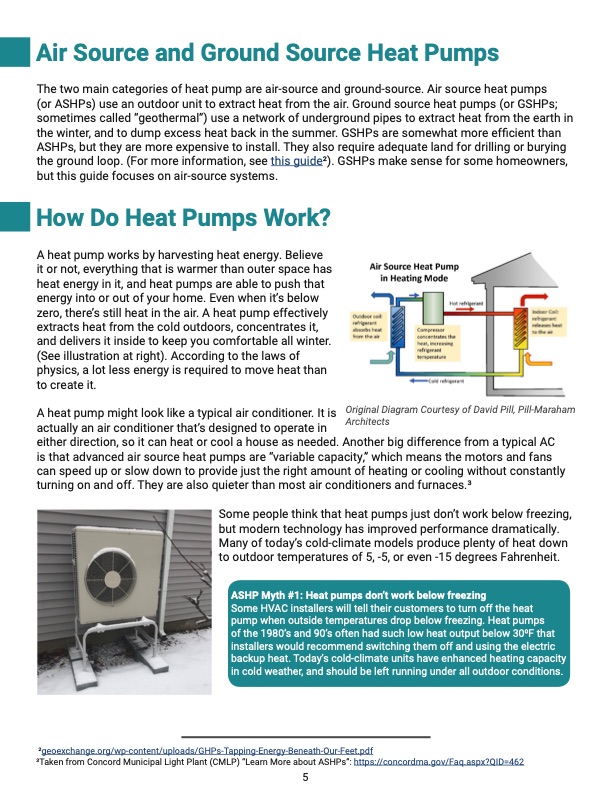
PDF Publication Title:
Text from PDF Page: 005
Air Source and Ground Source Heat Pumps The two main categories of heat pump are air-source and ground-source. Air source heat pumps (or ASHPs) use an outdoor unit to extract heat from the air. Ground source heat pumps (or GSHPs; sometimes called “geothermal”) use a network of underground pipes to extract heat from the earth in the winter, and to dump excess heat back in the summer. GSHPs are somewhat more efficient than ASHPs, but they are more expensive to install. They also require adequate land for drilling or burying the ground loop. (For more information, see this guide2). GSHPs make sense for some homeowners, but this guide focuses on air-source systems. How Do Heat Pumps Work? A heat pump works by harvesting heat energy. Believe it or not, everything that is warmer than outer space has heat energy in it, and heat pumps are able to push that energy into or out of your home. Even when it’s below zero, there’s still heat in the air. A heat pump effectively extracts heat from the cold outdoors, concentrates it, and delivers it inside to keep you comfortable all winter. (See illustration at right). According to the laws of physics, a lot less energy is required to move heat than to create it. A heat pump might look like a typical air conditioner. It is actually an air conditioner that’s designed to operate in either direction, so it can heat or cool a house as needed. Another big difference from a typical AC is that advanced air source heat pumps are “variable capacity,” which means the motors and fans can speed up or slow down to provide just the right amount of heating or cooling without constantly turning on and off. They are also quieter than most air conditioners and furnaces.3 Some people think that heat pumps just don’t work below freezing, but modern technology has improved performance dramatically. Many of today’s cold-climate models produce plenty of heat down to outdoor temperatures of 5, -5, or even -15 degrees Fahrenheit. ASHP Myth #1: Heat pumps don’t work below freezing Some HVAC installers will tell their customers to turn off the heat pump when outside temperatures drop below freezing. Heat pumps of the 1980’s and 90’s often had such low heat output below 300F that installers would recommend switching them off and using the electric backup heat. Today’s cold-climate units have enhanced heating capacity in cold weather, and should be left running under all outdoor conditions. 2geoexchange.org/wp-content/uploads/GHPs-Tapping-Energy-Beneath-Our-Feet.pdf 3Taken from Concord Municipal Light Plant (CMLP) “Learn More about ASHPs”: https://concordma.gov/Faq.aspx?QID=462 Original Diagram Courtesy of David Pill, Pill-Maraham Architects 5PDF Image | Air Source Heat Pump Buying Guide

PDF Search Title:
Air Source Heat Pump Buying GuideOriginal File Name Searched:
ASHP_buyingguide_5.pdfDIY PDF Search: Google It | Yahoo | Bing
CO2 Organic Rankine Cycle Experimenter Platform The supercritical CO2 phase change system is both a heat pump and organic rankine cycle which can be used for those purposes and as a supercritical extractor for advanced subcritical and supercritical extraction technology. Uses include producing nanoparticles, precious metal CO2 extraction, lithium battery recycling, and other applications... More Info
Heat Pumps CO2 ORC Heat Pump System Platform More Info
| CONTACT TEL: 608-238-6001 Email: greg@infinityturbine.com | RSS | AMP |